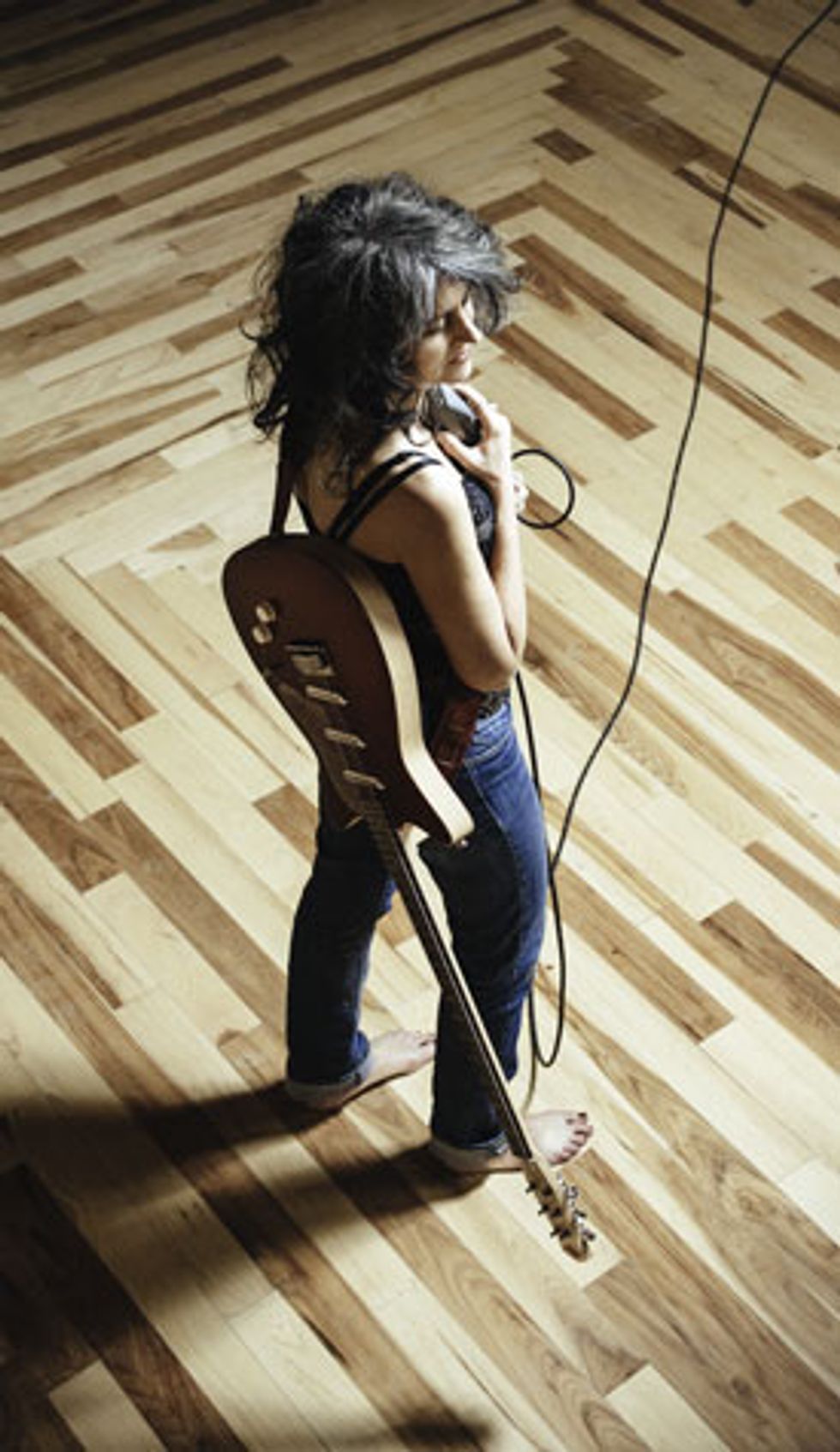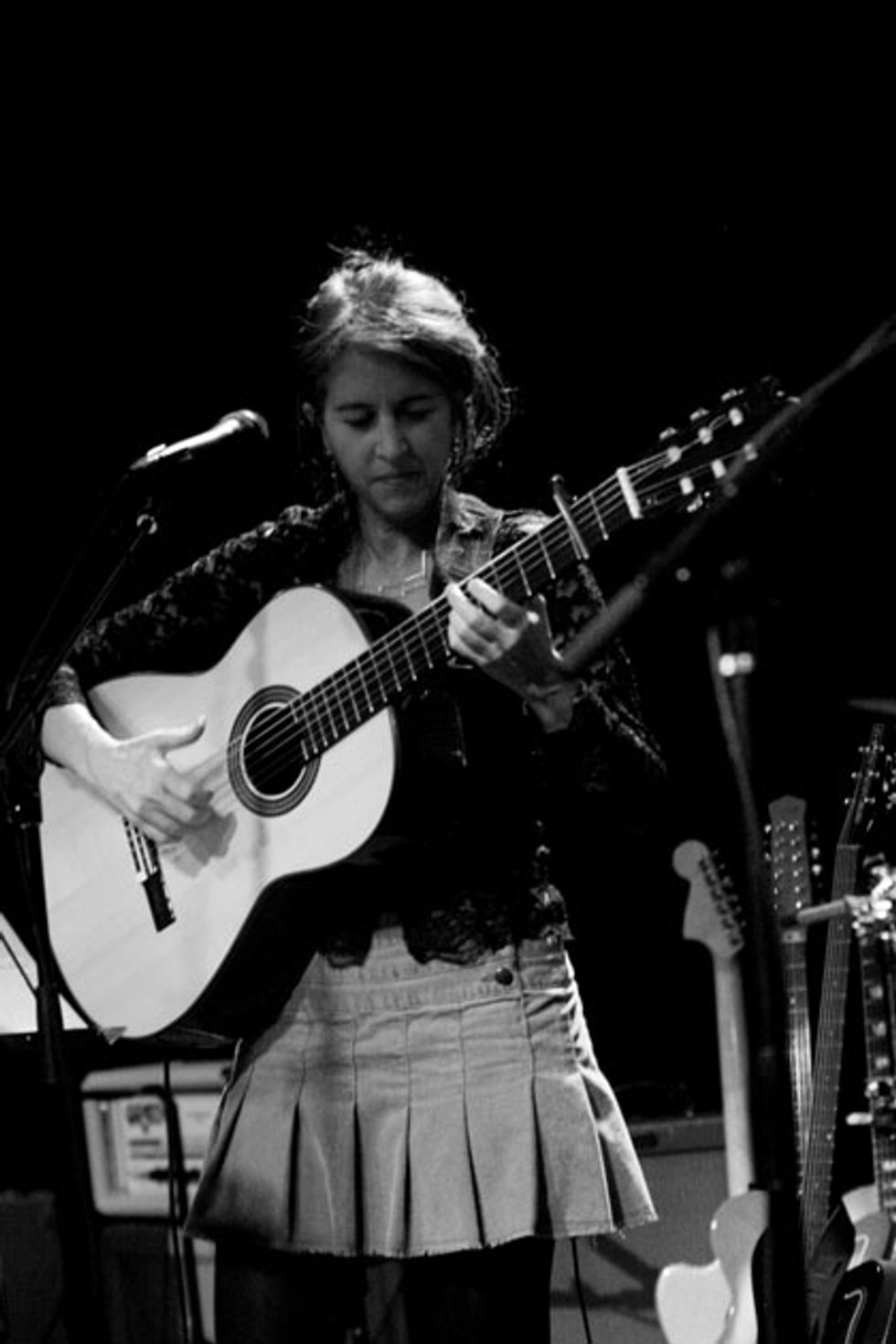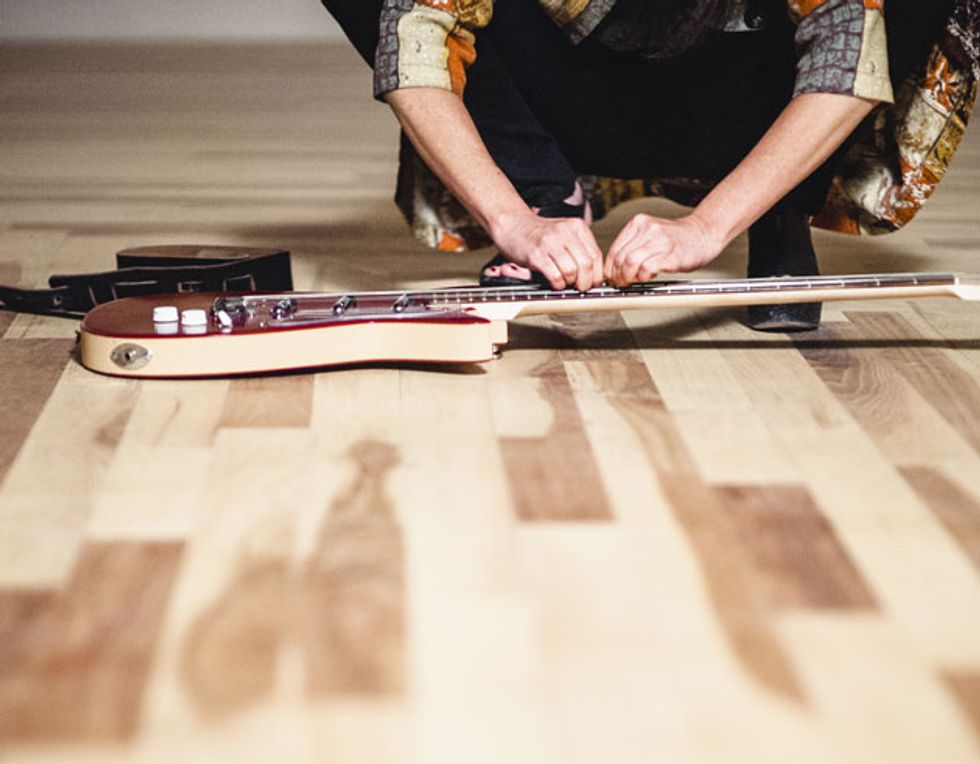The discovery of prepared guitar was a “peanut-butter-and-chocolate moment” for Denver-based experimentalist Janet Feder, shown here with her custom nylon string baritone. Photo by Michael McGrath/McGphotos
Denver-based guitarist Janet Feder isn’t interested in fitting in. The 56-year-old plays baritone guitars exclusively, often using alternate tunings, and she further distinguishes herself by utilizing “prepared” guitars adorned with various objects on her strings (like metal rulers, beads, thread, horsehair, and rocks), producing sounds that are by turns soothing and disorienting, lush and discordant.
Stylistically, Feder covers a lot of ground. She touches on elements of jazz, classical, folk, minimalism, and avant-garde—sometimes combining genres within the space of a single song. Asked to categorize her music, she lets out a laugh and says, “That’s the infinitely unanswered question. It’s not strictly any one thing, although I’ve had some traction in the avant-garde world. Honestly, whenever somebody asks me, ‘What kind of music do you play?’ I just say, ‘I play guitar music.’”
Feder describes herself as being “fairly nomadic” during her teens and 20s, living everywhere from the Pacific Northwest to Southeast Asia while studying classical guitar. “I moved to places where there were teachers I wanted to study with,” she says. “I got jobs, studied, played, and practiced.” Returning home to her native Denver in her late 20s, she played solo gigs and performed with an array of bands (“lots of wallpaper shows and stuff like that”) before coming to the attention of and collaborating with creative guitarists such as Fred Frith, Bill Frisell, and Henry Kaiser. Feder has issued a handful of recordings—Icyimi (1995), Speak Puppet (2001), Ironic Universe (2006, a duet with Frith), Songs with Words (2012), and Leavings (2014)—that spread the word of her iconoclastic approach to the guitar, and now she’s released her most fully realized work with the album THISCLOSE.
Songs don’t always behave in traditionally accepted ways on THISCLOSE, and that’s one of the album’s many charms. Whether Feder is conjuring up frenzied, enveloping soundscapes (all without digital effects) on tracks like “Crows” and “No Apology,” offsetting off-kilter banjo picking with crashing plates and glasses on the unsettling “Ticking Time Bomb,” or drawing listeners into a trance-like state on the acoustic meditation “You as Part of a Whole,” the fingerpicking guitarist allows her melodies to exist ephemerally. Nothing resolves as you might expect: a new surprise—a dramatic mood shift, a sudden sonic curveball—always seems to exist around the corner.
Feder sat down with Premier Guitar to discuss the ins and outs of playing prepared guitars (including which objects don’t work so well), the sonic textures she weaves throughout THISCLOSE, her guitar and amp considerations, and more.
Your sound and approach are so original. What influenced you as a teenager?
I loved rock ’n’ roll. I’m so lucky that I got to grow up in the ’60s and ’70s, so I was listening to everything from Jimi Hendrix to Janis Joplin to Crosby, Stills & Nash. I loved the music of Joni Mitchell. I thought her guitar playing was so interesting before I even knew anything about alternate tunings. We listened to all kinds of music at home: Bach, Beethoven, Caribbean music, Édith Piaf. Then, in my own bedroom, it was Eric Clapton and the Doors and that whole rich world of rock ’n’ roll.
How did you start preparing your guitar strings with various objects?
I was sort of working on an art project. I had my guitar with me and a lot of materials were scattered around. It was that peanut-butter-and-chocolate moment, where these two things came together.

When Feder, with her Jerry Jones Neptune slung over her back, first heard the baritone guitar, she recalls that “it filled all the places inside me with a sound that I’d been wanting to hear my whole life and hadn’t really been able to access.”
I was really shy about it at first, because I hadn’t looked out into the world to find other people who, of course, had done things like this. I heard Fred Frith play, and I knew he played his guitar with objects not typically associated with the guitar. But I wasn’t aware of other people doing anything like that. So while I was reticent, I also thought, “This is amusing to me. Does it have legs?”
Now you do this on both acoustic and electric guitars. Are there any items that work on acoustic that don’t work on electric?
There are things that work on nylon strings that don’t work on steel strings. Some things work well on both, even though they sound very different on both. Because I’m mostly a nylon-string player, I strive to find a way to play an amplified nylon-string guitar with objects on the strings but to not brutalize an audience, because the sounds can be sort of renegade in a big room. I had to work on the technology aspect of it. There can be a lot of feedback. I’m using a combination of altered and unaltered strings. That’s what appeals to me the most—using this combination of both.
Object-wise, has there been anything that looked good on paper but didn’t really work when you tried it on the guitar?
Thousands of things. I’ve spent a lot of time in hardware stores trolling the bins for interesting little metal things. As you would imagine, metal objects like rulers and files produce some really cool sounds. You would think that springs of various sizes and shapes would have some kind of interesting play on a string, but that’s not the case. Springs don’t work at all for me.
Feder prepares her Jerry Jones Neptune baritone electric for … anything! Her uncompromising music knows
no sonic or genre bounds.
On “Crows,” you turn wild squalls of feedback into arresting soundscapes. How do you utilize feedback musically?
There are two things happening on the guitar solos on “Crows.” One is that my engineer, Mike Yach, is playing some of those electric guitar solos. It’s not a baritone guitar; it’s a regular electric guitar. Mike is a genius and a wonderful guitar player. He recorded those on his own, and I thought they were amazing.
There’s another guitar solo on that song that I play through an old tape machine. It was like an Echoplex. We took a tape off the spool, crunched it up like a wadded-up piece of paper, and put it back on the spool. I played through that.
Janet Feder’s Gear
GuitarsMilan Sabljić baritone classical (custom)
Jerry Jones Neptune baritone electric
Rick Turner Renaissance baritone electric (nylon)
Amps
AER Compact 60 for small club gigs
Radial JDI direct box for large venues
Effects
Split rings (various sizes)
Horsehair
Bicycle inner tubes
Small rubber Super Ball
Rocks
Ball bearings
Brass string end beads
Metal rulers
Steel files
Various other small objects
Strings and Picks
D’Addario EJ46TT Pro Arté Dynacore titanium nylon hard tension (.028–.046)
D’Addario Pro Arté lightly polished clear nylon hard tension (.029–.035)
D’Addario Classic nylon silverwound individual strings (.054 or .056, for the low B)
D’Addario EXL158 Nickel Wound Baritone Lights (.013–.062)
“Ticking Time Bomb” has a mixture of banjo with various sound effects. Are you preparing the banjo as well?
Yeah. It’s an old, very inexpensive tenor banjo. There’s no guitar on that song. It’s just banjo, bass, harmonica, clarinet, and accordion. I’ve got friends on all those other instruments, and I’m playing the banjo—a borrowed banjo, I should add.
“No Apology” and the title track aren’t really what I would call “guitar pieces” per se. They’re built solely on sound treatments.
Both of those pieces were improvised live in the studio. “No Apology” was a drummer named Todd Bilsborough and me. The core of the track is improvised in the studio from start to finish, just guitar and drums. The same with “THISCLOSE.” Joe Shepard, my producer, Mike Yach, and I developed a way of playing and exploring in the studio, just making the sounds that we want to hear. On the title track, I play a bunch of different objects and sounds all live. We manipulated them a little bit through tape machines. There’s not a digital effect on the album.
The repetitive noise that you hear on the title track is me flipping a little clip thing on a Dutch doorbell and playing to the entire track. Everything, even the wind and crickets, it’s all live in the studio.
Your music seems to touch on so many genres. Do you have different playing styles for different genres?
Absolutely. You have to. This is one of the advantages of being a 56-year-old musician. I’ve lived through a lot of eras of sound, so I’m not really focused on one thing for my whole musical life. Each genre requires a different touch, for sure, but it’s all part of a broad landscape that exists in my head.
What do you like so much about playing baritone guitars?
I liked it so much the first time I heard one. It was a piece that Miroslav Tadic played for me. It was a Macedonian folk song he arranged. I heard this piece of music and cried. I couldn’t help it—it was so beautiful. The low end of a baritone guitar is so deep and low; it’s like the most beautiful low note that you could imagine somebody singing. It just rumbled through my body.
The advantage to the baritone is that with a longer scale, you end up with a bigger, lower bottom end. It filled all the places inside me with a sound that I’d been wanting to hear my whole life and hadn’t really been able to access.
What are your main guitars in the studio?
My main guitar in the studio is my baritone classical. It’s made by Milan Sabljić. I have a Rick Turner baritone classical that’s amplified, so it’s a baritone electric. I also have a Jerry Jones Neptune baritone electric guitar that I really love. It’s pretty much those three.
YouTube It
Janet Feder explains how preparing one of her guitar strings with a metal object can alter its sound, then demonstrates her fingerpicking technique while playing “Happy Everyday, Me” from her new album, THISCLOSE.
Are any amps particularly complementary to prepared guitars?
That’s such a great question. It’s taken me a long time to sift through a huge landscape of amplification to figure out what works for me. For what I do with a guitar, an amp is best when it stays out of my way and gives me only really clean amplification. That’s really all that I want: more volume but a clean sound. I use AER amps. Otherwise, I usually go direct.
Have you turned anyone else on to playing prepared guitars—someone that didn’t know what you were doing at first, and went, “Wow, I’m going to try that?”
I get to teach a lot when I tour, so I’ve done clinics and stuff as far away as Austria. I get to teach at CalArts once a year. I encounter a lot of young people who seem to come away very inspired. It’s more about letting people know, “You can listen differently.” It’s not so much about the objects. It’s about listening and using your imagination.













![Rig Rundown: Russian Circles’ Mike Sullivan [2025]](https://www.premierguitar.com/media-library/youtube.jpg?id=62303631&width=1245&height=700&quality=70&coordinates=0%2C0%2C0%2C0)











![Rig Rundown: AFI [2025]](https://www.premierguitar.com/media-library/youtube.jpg?id=62064741&width=1245&height=700&quality=70&coordinates=0%2C0%2C0%2C0)




















 Zach loves his Sovtek Mig 60 head, which he plays through a cab he built himself at a pipe-organ shop in Denver. Every glue joint is lined with thin leather for maximum air tightness, and it’s stocked with Celestion G12M Greenback speakers.
Zach loves his Sovtek Mig 60 head, which he plays through a cab he built himself at a pipe-organ shop in Denver. Every glue joint is lined with thin leather for maximum air tightness, and it’s stocked with Celestion G12M Greenback speakers.











